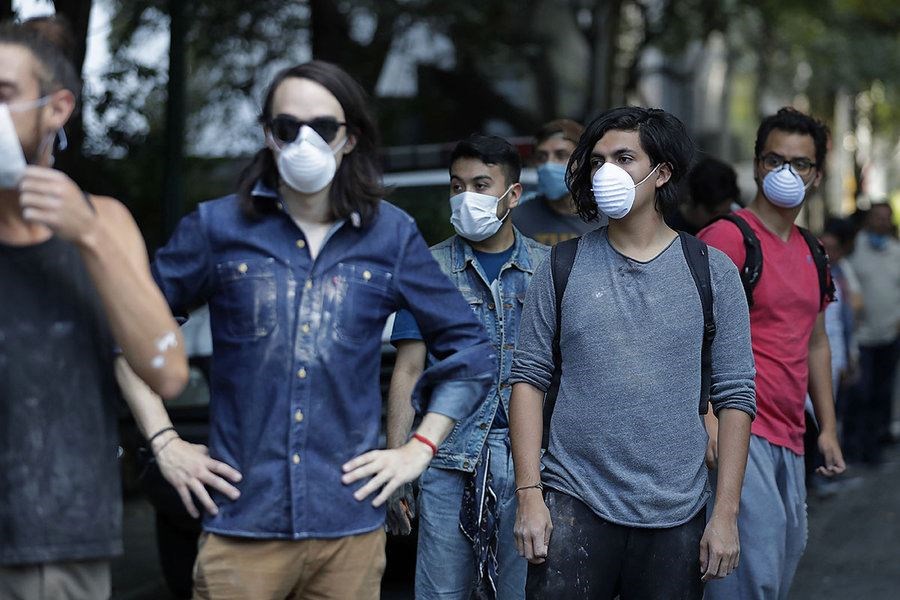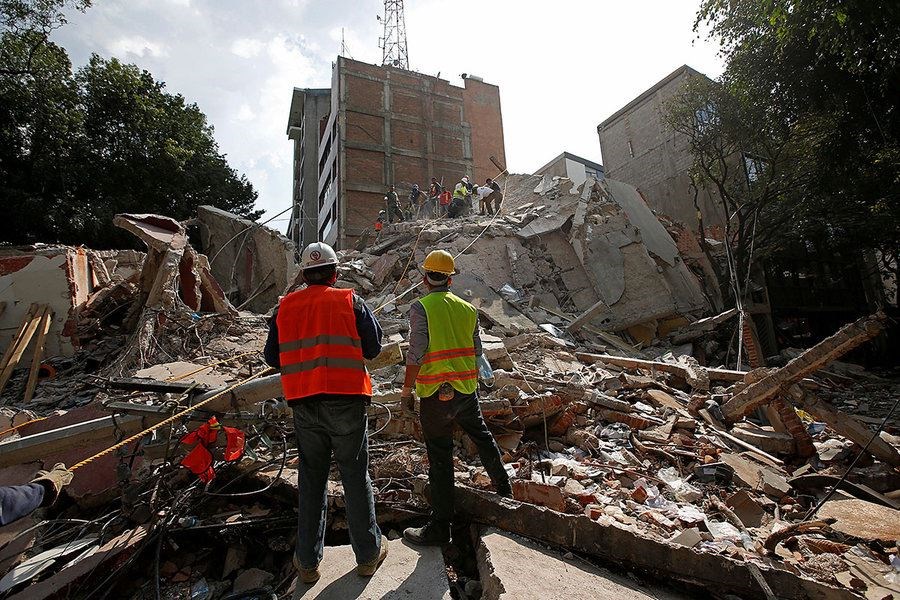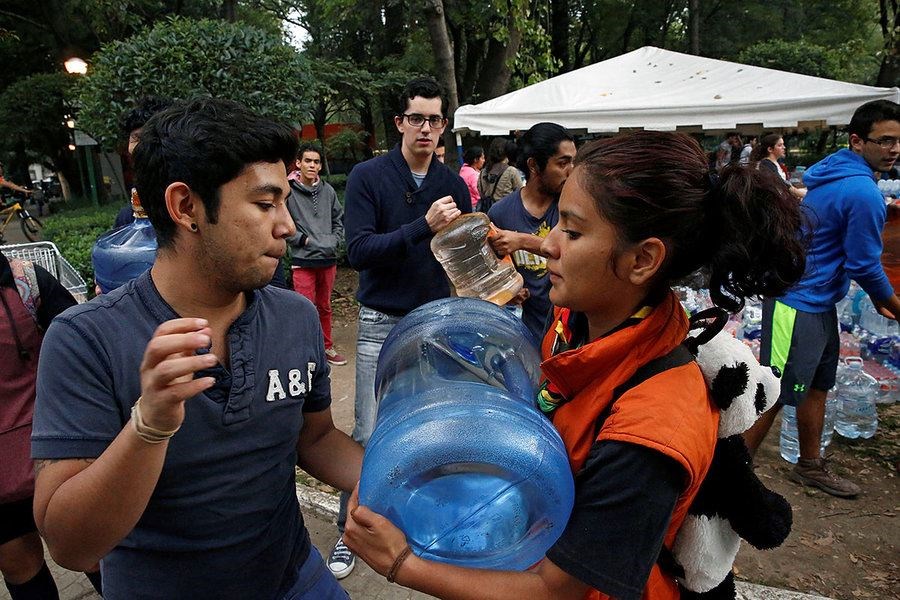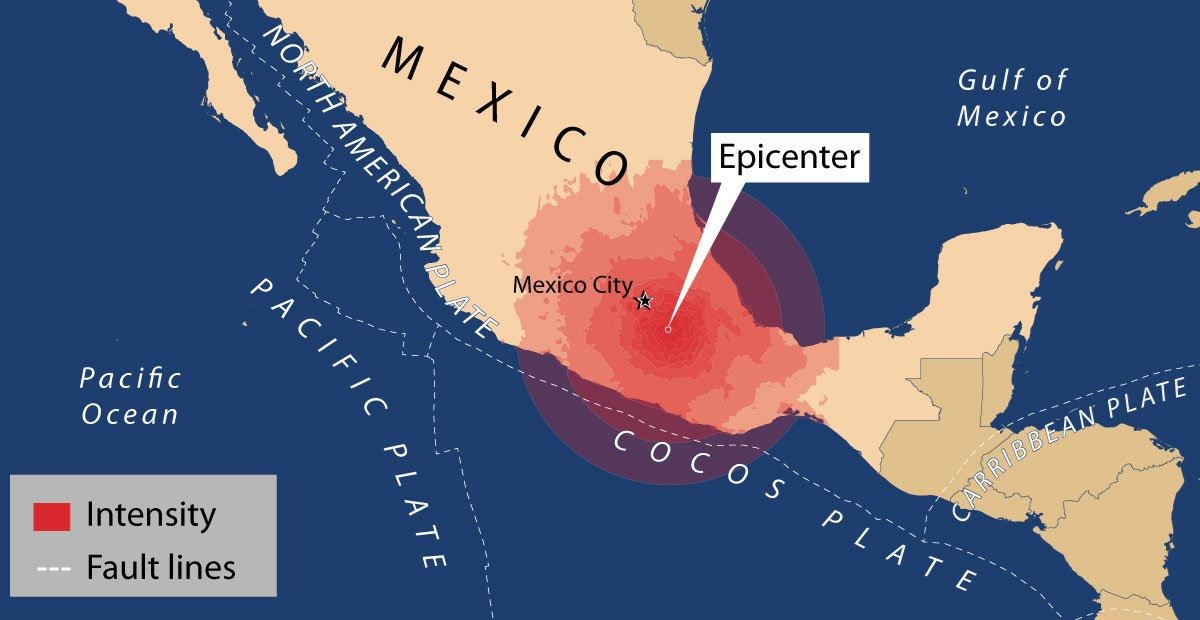Permission to use this
material was granted by
The Christian Science Monitor
MEXICO CITY—Baruch García stood at an intersection Tuesday afternoon after a deadly earthquake, trying to direct traffic away from a road cutting through La Condesa’s lush Parque México. On the other side of the park, hundreds of volunteers – from a young boy in a yellow soccer uniform, to a woman in slacks and ballet flats, and a man wearing an apron from a nearby café – lined the street for blocks, helping to remove rubble from an eight-story collapsed building with an unknown number of people buried inside.
Tuesday afternoon, a 7.1 earthquake in nearby Puebla State rocked Mexico City, some 75 miles away. It toppled homes, schools, and other structures, trapping citizens and killing at least 86 in the capital and a total of 217 nationwide, according to the Mexican Civil Defense Agency. The death toll is expected to rise. Mr. García was in the park walking his dogs when the quake hit.
 Volunteers wearing dust masks wait in line to pass rubble as rescue workers search inside a collapsed bilding in the Condesa neighborhood of Mexico City Sept.19. A magnitude-7.1 earthquake stunned central Mexico killing more than 200 people as buildings collapsed.Rebecca Blackwell/AP“The first thing I thought when it was over was, ‘I have to help,’ ” he says. Someone called out that a building had fallen on the other side of the park – they needed traffic to stop. So, he pulled his car around to the intersection and blocked it, along with one other person’s car. They posted small hand-written signs that read, “No hay paso,” only moving one of the vehicles when soldiers, ambulances, or other officials needed through.
Volunteers wearing dust masks wait in line to pass rubble as rescue workers search inside a collapsed bilding in the Condesa neighborhood of Mexico City Sept.19. A magnitude-7.1 earthquake stunned central Mexico killing more than 200 people as buildings collapsed.Rebecca Blackwell/AP“The first thing I thought when it was over was, ‘I have to help,’ ” he says. Someone called out that a building had fallen on the other side of the park – they needed traffic to stop. So, he pulled his car around to the intersection and blocked it, along with one other person’s car. They posted small hand-written signs that read, “No hay paso,” only moving one of the vehicles when soldiers, ambulances, or other officials needed through.
García wasn’t the only one moved to help. The moment the ground stopped trembling, Mexico City residents jumped into action, directing traffic after street lights went out, offering the use of bathrooms or telephones, setting up collection sites for food, water, flashlights, and blankets, and using their bare hands or tools at their disposal to remove rubble in hopes of rescuing residents trapped in buildings. At least one engineering firm announced free home inspections and ride-share companies were temporarily offering free transport.
The response is in part a legacy of Mexico’s haunting 1985 earthquake, which left an estimated 10,000 people dead and another 30,000 wounded. The government’s reaction at the time was disorganized and inept, and as a result, citizens took search, rescue, and post-quake support into their own hands, creating grassroots civilian response teams.
Yesterday’s temblor fell on the 32nd anniversary of the 1985 quake. Just hours before the ground began to violently shake, office buildings and schools across the city participated in an earthquake drill, a citywide alert system sounded through the streets, and government officials attended commemorations of the event that still haunts this megacity.
 Rescue workers look at fellow workers searching for people under the rubble of a collapsed building after an earthquake hi Mexico City, Mexico September 19, 2017.Carlos Jasso/ReutersRoughly two hours later, some alarms went off again, but this time it was not a drill.
Rescue workers look at fellow workers searching for people under the rubble of a collapsed building after an earthquake hi Mexico City, Mexico September 19, 2017.Carlos Jasso/ReutersRoughly two hours later, some alarms went off again, but this time it was not a drill.
The city’s earthquake alarms, coupled with stronger building codes and official action plans, are a testament to improvements in government preparedness and response since 1985. However, in the immediate aftermath it was clear that citizens were well-versed in responding to disasters.
“We don’t have a lot of faith in our institutions, so we’ve learned to jump in and help instead of waiting,” says José Cruz, a lawyer organizing water donations in an amphitheater inside Parque México.
Volunteers, many communicating via social media, gathered on the concrete plaza to organize donations of water, cleaning supplies, trash bags, bread, and blankets and direct them to nearby sites in need. Gabriel Carillo, a life coach, held up a poster that read “We need flashlights in the Parque México esplanade,” and asked passersby to take a photo and post it on social media.
“This is Mexico,” says Alejandro Lira, who wasn’t alive for the ’85 quake but rushed to help gather supplies for victims this week. “We are neighbors, we believe in solidarity.”
 People carry donations of bottled water for rescue workers and victims next to a collapsed building after an earthquake in Mexico City, Mexico on Sept. 20, 2017.Henry Romero/ReuterAn employee of the Cuahtémoc borough, where Condesa is located, walked onto the plaza and was instantly bombarded with requests from volunteers.
People carry donations of bottled water for rescue workers and victims next to a collapsed building after an earthquake in Mexico City, Mexico on Sept. 20, 2017.Henry Romero/ReuterAn employee of the Cuahtémoc borough, where Condesa is located, walked onto the plaza and was instantly bombarded with requests from volunteers.
“We need a generator,” José Luis Jimenez, a leader of Scout troop #24, called out. Six members of his troop were there helping organize and deliver donations. “People from the neighborhood are coming here to spend the night. We need to provide security, emotional support. In a few hours, everything will be black,” he says. The neighborhood was overwhelmed with families pulling rolling suitcases and carrying pet crates. They wouldn’t go home to sleep, either because they were told their building wasn’t safe, or they decided it themselves.
Alain Sanchez, the Cuahtémoc borough worker, said he was impressed by the civilian response. “A building fell and by the time we got there, there were already crowds of people helping. We’ve seen incredible support from civil society,” he says.
Mexico is prone to earthquakes, but Mexico City itself is not on a fault line. Instead, its location upon a former lake bed means it’s vulnerable to temblors hundreds of miles away. This is Mexico’s second big quake in just as many weeks. More than 90 people in the southern states of Chiapas and Oaxaca died in an 8.1 quake on Sept. 7, the country’s most powerful in decades.
 Mayor Miguel Ángel Mancera said 44 buildings collapsed or were badly damaged, including a grocery store and a factory. More than 30 children and five adults were found dead in a flattened school in the south of the city, and another 30 children were still unaccounted for, President Enrique Peña Nieto announced.
Mayor Miguel Ángel Mancera said 44 buildings collapsed or were badly damaged, including a grocery store and a factory. More than 30 children and five adults were found dead in a flattened school in the south of the city, and another 30 children were still unaccounted for, President Enrique Peña Nieto announced.
On the other side of Parque Mexico, tree branches twisted with rebar and concrete slabs buckled over the street at one rescue site. Civilians digging through the rubble wearing thin medical masks and often using their bare hands were replaced by firefighters and soldiers, who climbed high onto the wreckage searching for survivors. Every few minutes volunteers on the street below threw their arms up, shaking their hands in a call for silence so that rescuers could hear any cries for help. The double line of volunteers moving debris snaked down the street that circles through the neighborhood. Men and women bent their knees under the weight of the concrete, passing buckets and boxes away from the site and moving empty containers back for another round.
One volunteer keeping the tree-lined walkway in the middle of the street clear called out to a crowd of curious onlookers, “If you aren’t here to help, please leave.”
Back at García’s makeshift road block, a soldier approaches. “Where did you say that other building collapse was?” he asks. García points toward neighboring Colonia Roma. “Are we already there? The Army?” he inquires. A bystander in a suit pipes in that he doesn’t think so and the soldier walks away. Moments later an ambulance pulls up. “Tamaulipas and Nuevo León – this way?” asks one of the three first responders crowded into the front seat.
García lets them through, and with little judgment. He says he isn’t surprised he’s being asked for guidance.
“The officials are here to serve the community, but most of the time they are focused on very different problems, like drugs,” García says. “I’m glad we can help them. It’s good to work together.”
Permission to use this
material was granted by
The Christian Science Monitor
Page created on 9/21/2017 6:33:53 AM
Last edited 9/21/2017 7:40:44 AM
